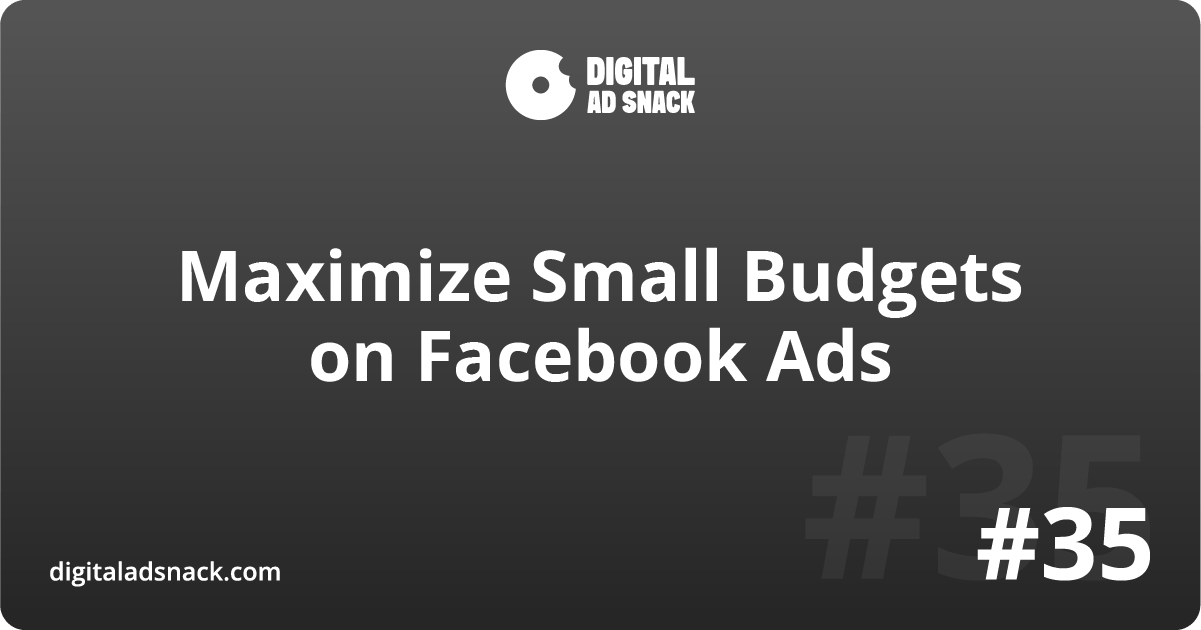When you have a small budget for Facebook Ads, let's say, €50 a day or less—every cent counts.
The way you structure your campaigns, your ad sets, and even your creative can make or break your success.
Most small advertisers think that splitting up this budget across multiple campaigns or ad sets will allow them to target different audiences, objectives, or creative ideas.
But this strategy can actually hurt performance and prevent you from getting the results you’re looking for.
Common Mistakes with Small Budgets
1. Fragmenting Your Budget
Creating multiple campaigns or ad sets might seem like a way to cover more ground, but it actually limits Meta's ability to gather enough data and optimize your ads.
Instead of spreading your budget thin, focus on one campaign with a single ad set to maximize results.
This dilutes the budget and makes it difficult for Meta’s algorithm to optimize effectively.
2. Focusing on Too Many Objectives
It can be tempting to run campaigns with different goals at once, but with a limited budget, it’s best to stick to one objective at a time.
Once that campaign has run its course, you can switch objectives and goals without compromising performance.
3. Overloading Campaigns
Running too many Ad sets and Ads at once can overwhelm your small budget.
Meta typically won’t show more than two or three ads, so stick to a limited number to increase performance and avoid wasted spending.
If you’re managing a small budget, the solution is simple: run only one campaign at a time with a single ad set.
This approach concentrates your budget on one goal, enabling Meta to optimize more efficiently, and ultimately getting you better results.
You’ll be able to generate more volume, gather more data, and you may even exit the Learning Phase.
Note: I have experienced great results with small budgets without exiting the Learning Phase. For example an Account that spend 90%+ in Learning Phase brought a consistent ROAS so I kept it running.
Once a campaign has run its course, feel free to switch it up and test something new. But while the campaign is live, keep it focused and simple.
I recommend the MVAC Framework for small budget advertisers, which I developed during the past few years running low-budget Ad Accounts.
The Minimal Viable Ad Campaign (MVAC) Strategy
This framework is designed to help you get the most out of your spend on Facebook Ads by simplifying your structure and focusing on the essentials.
Let’s break down the core components of the MVAC strategy:
Step 1: Simple Structuring
Step 2: Messaging
Step 3: Testing and Analysis
Step 4: Scaling Winners
Step 5: Rinse and Repeat
Step 1 - Simple Structuring
At the core of the MVAC framework lies a simplified campaign structure:
1 Campaign
1 Ad Set (Advantage+ targeting)
3 ads: image, carousel, video
This minimalist structure allows for focused testing and optimization, leveraging the power of Meta’s AI to enhance targeting efficiency.
By consolidating your ads into one campaign, you maintain a clear focus on testing and refining your messaging and creative elements.
Step 2 - Messaging
Central to the success of any Facebook ad campaign is the messaging. The MVAC framework emphasizes simplicity and clarity in crafting compelling ad copy:
1-3 headlines
1-3 body text variations
CTA: Maximum 2 variations
Each element of the ad copy should adhere to a structured format, encompassing a hook, problem identification, solution presentation, and a clear call-to-action (CTA).
Step 3 - Testing and Analysis
The cornerstone of the MVAC strategy lies in the process of testing and learning:
Monitor ad performance
Analyze successful combinations
Optimize based on insights
To maximize the efficacy of testing, it's crucial to establish clear parameters and timelines.
Allow campaigns to run for 4-5 days with designated budgets to facilitate meaningful data collection.
Start with €10-€15 per day, or allocate 15-20% of your overall budget to testing.
Step 4 - Scaling Winners
Once you identify successful ad variations, it's time to scale up strategically:
Increase budget on high-performing ads
Kill underperforming ads
Maintain campaign continuity
Scaling efforts should be gradual and focused. Increase the budget by 20-30% daily on well-performing ads, while cutting the ones that don't bring results.
Don’t stop a good-performing campaign—simply start a new one to test different ads using the MVAC system.
Step 5: Rinse and Repeat
Continuous improvement is key to the MVAC framework:
Adjust based on results
Explore new testing avenues
Refine and optimize
By continuously testing new messaging angles and ad types, you’ll discover winning combinations and ultimately have long-term success with Facebook Ads.
Always be testing and tinkering!
Want to dive deeper into the MVAC framework?
Check out DAS #04, where I break down the entire MVAC strategy in detail:
Conclusion
Running Facebook Ads on a small budget doesn’t have to be complicated.
By using the MVAC framework, you simplify your structure, focus your messaging, and continually test and refine your ads for better results.
Start small, focus on what works, and scale up once you have winning ads.
As we approach the BFCM season, this approach is especially valuable for small businesses with limited budgets.
(I'm writing this in October 2024).
Keep your campaigns simple, and focus your budget on one objective at a time.
Whether it’s a BFCM campaign or your year-round ads, this strategy will help you maximize your ad spend and get the best results.
Ready to implement these tips?
Get started with the MVAC strategy and take control of your ad performance today!

